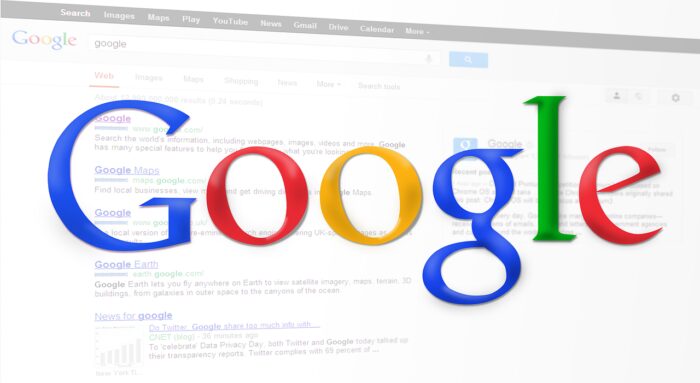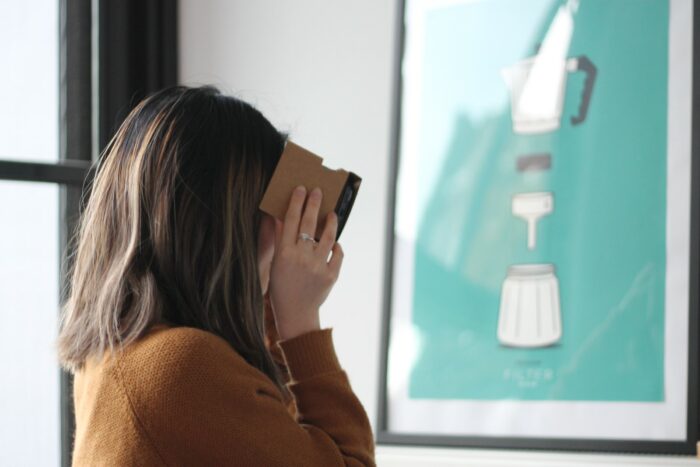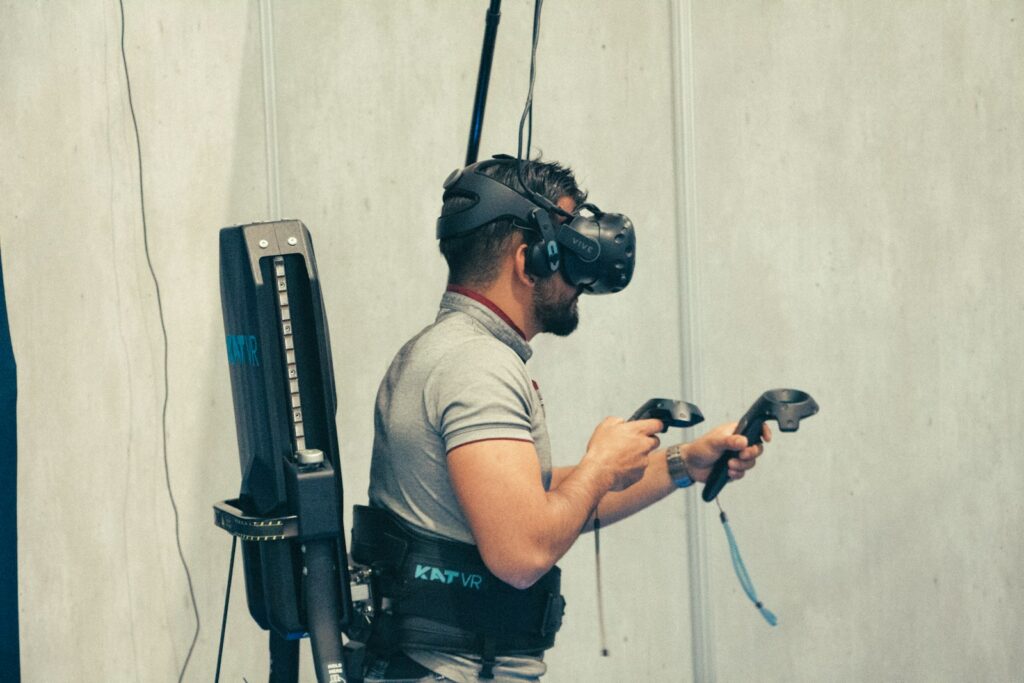We’ve witnessed exponential growth in the Metaverse in 2022, and large tech giants such as Google, Meta, and Microsoft working on different interactive virtual worlds. Primarily known for dominating the search engine market, Google has also launched several projects to contribute to the Metaverse.
In this article, we take a closer look at Google Metaverse, its products, technologies, strengths, and weaknesses.
Key Points
- Google has made several acquisitions to contribute towards Metaverse technologies, such as acquiring Raxium to obtain AR/VR hardware solutions.
- Google Metaverse is currently working on Google Iris and Starline projects to create gadgets that will fully immerse users in virtual worlds.
- Google has created many VR and AR products, such as Google Glass, Google Glass Edition 2, Google Cardboard, etc.
Google’s Background in Metaverse
During its Cloud Next 2022 event, Google announced a partnership with Coinbase to provide robust and secure cloud services. This indicates their involvement within the Web3 space, apart from their other Metaverse projects.
Project Starline enables users to create 3D representations for individuals within alternate realities to provide immersive experiences. The technology utilizes cameras and sensors to create 3D models for online conferences, meetings, and much more. The project emphasizes the ability to “feel as if the person is in the same room as you.”
During COVID-related lockdowns, Google prepared catchy and improved backgrounds for their “Google Meet” video calls where you can sit in your home and have any background you like. These immersive backgrounds revealed by Google have been considered one of the company’s first steps toward the Metaverse. These backgrounds have all the seasons, subtle animations, and more that make it appear as if you are really in that situation.
Moreover, Google’s constant journey from the Google cardboard to now the Google daydream powerfully depicts their interest in harnessing the potential of the Metaverse. Google’s parent company Alphabet has also invested heavily in blockchain providers such as Dapper Labs, Voltage, Fireblocks, and Digital Currency Group.
Google Metaverse Projects
Google has been working on different innovative projects to contribute towards the Metaverse. These include:
Google Project Iris
Google’s Project Iris offers a unique approach to utilizing augmented reality. The project focuses on creating thin AR glasses to provide incredible visuals.
With AR technology, the most challenging aspect is displaying 3D virtual objects within the user’s physical realm. It is even more difficult to incorporate it into small glasses instead of bulky headsets. However, with Google’s technological capabilities, anything seems attainable.
The glasses appear to process visuals separately using Google’s cutting-edge supercomputers. If so, this innovation, which surpasses earlier advancements in the sector, may offer the most precise mix of a view of the physical world and the larger Google Metaverse.
Most of Project Iris’s details are being kept a secret by Google. Therefore most details online are speculation. The project is planned to be released by 2024. Only three hundred people work for Project Iris, and they are bound by strict confidentiality agreements.
Google Project Starline
Combining the real world and the Metaverse is frequently the aim of augmented reality. This innovative project focuses on establishing borderless connectivity through realistic video calls that are incredibly immersive. Participants enter the Starline booth and are tracked by numerous cameras and sensors to project a lifelike representation in front of each other.
Google has positioned it as a specific type of enchanted window. It is a 2-way display that provides a peek into another linked Google Project Starline device. It has a few aspects similar to their online video meeting technology. For the ultimate customer, size is the prominent differentiation. The other individual is shown in their actual size on the life-size display from Starline. Project Starline, however, uses trendy and modern computers to enhance depth and volume, giving individuals a 3D look.
4 Most Significant Google Metaverse Products
Google has been working on virtual reality and augmented reality long before it joined Metaverse. One of their significant releases was their Google glasses in 2013, which were not highly advanced but were still good. Here are a few significant products for the Google Metaverse.
1. Google Glass
Many say that Google Glass was released before the public was ready for this type of technology. It was released in 2013 and initially faced a lot of criticism. It offered a 3-5 hour battery life and allowed essential functions such as checking messages, viewing photos, and browsing the internet.
Google initially advertised it as containing augmented realities. For example, their promotion in 2012 showcased adventurous skydiving and other activities. However, the advertisements later changed their focus towards providing real-time information during activities.
Despite the criticism, the product displayed enough potential for Google to release another edition, which we’ll discuss below.
2. Google Glass Edition 2
As stated above, the initial Google Glass was one of the first augmented reality devices to enter the market. But in 2013, it disappeared. So, one of the first Google Metaverse devices that shows Augmented Reality’s current potential by building upon the original idea is the Glass Enterprise Edition 2.
The XR1 processor in Google’s most recent Glass offers efficient processing and state-of-the-art Artificial Intelligence capability. In addition, the intelligence in the creative design provides excellent working and improved optics-dependent processing.
This Metaverse gear features a camera field of view of 80 degrees and full 720p video capabilities. There is also built-in GPS and dual-band WI-FI. The Glass can also be modified to have an eight-megapixel camera for high-definition video. In addition, the Google Glass Edition 2 is very easy to use because of the voice-command feature.
3. Google Cardboard
Google Cardboard, which was initially demonstrated at the 2014 Developer Conference and later gained notoriety, is the name most people associate with smartphone-based VR headsets. Cardboard is appropriate for those who wear glasses and provides cohesiveness, convenience, and light sealing. It is also completely capable of working with Android & Apple.
Your phone serves as both a display and a sensor. Users can experience virtual reality when they place it within the Cardboard. Head motions are concurrently detected by the sensors (gyroscope) and translated into the virtual environment.
The picture follows your gaze in all directions. If you look up, it follows you higher. This gives the impression that you are at the center of everything. Google Cardboard was also referred to as 360-degree glasses because it can rotate in all directions.
The Cardboard box has to be manually held in front of your eyes. The picture is enlarged by the lenses, which have the effect of a magnifying glass, filling practically the whole field of vision. On the screen, a small offset image is displayed for each eye, giving the sensation of space. Since the underlying Google Cardboard concept is always the same, several variations of it have been created since 2014, including Google Daydream, which we will discuss next.
4. Google Daydream
Google Daydream is considered to be a sequel to the well-known Google Cardboard. This product functions identically to Cardboard by efficiently transforming your phone into a virtual reality display. The primary difference is that Daydream includes other interactive hardware. Daydream comprises of a simple virtual reality controller and a headgear with a slot to fix your mobile. Daydream’s hundred-dollar price tag did not provide extraordinary features above the regular Cardboard.
The technology was released in 2016 and is considered incredible for that era. However, as per Google, the main reason for the failure of this gadget was that Daydream consumers sometimes experienced lost connections to their mobiles. Nevertheless, the ability to use a mobile to place a call or view an application is still available while using the VR controller.
Pros & Cons of Google Metaverse
Since there is not much known about their Metaverse yet, we will do a quick analysis of the strengths and weaknesses of their Metaverse-related products.
Pros
Some of the strengths of the Google Metaverse include the following:
Incredible Processing Capabilities
Google Cloud’s quick processing capabilities enable it to render videos much quicker than other technologies. This allows for faster iterations and seamless holographic projections. In addition, this innovative technology can also bring quicker rendering to low-end mobile devices, thus contributing immensely toward adding value to the Metaverse.
New Communications Technologies for Offices and Schools
COVID was a major factor in the increase in the use of virtual meeting services like Google Meet, Microsoft Teams, Zoom Video Calls, and others. The creation of entertaining and interactive events for all participants is one of the advantages of the Metaverse for improving engagement. In addition, users may find chances for exciting and dynamic connections amongst participants thanks to the immersive encounters and visually rich three-dimensional digital landscapes.
Rather than utilizing a computer, mic, or any other device to speak with your peers, you may use digital workspaces or classes. This concept allows users to interact with their peers’ true virtual personalities and explore digital workplaces or learning settings in 360-degree perspectives.
New Advertising Possibilities
With Google’s massive user base, they have plenty of user data to market their Metaverse effectively. As a result, marketing within the Metaverse is expected to be drastically different from traditional marketing.
Using the cloud, brands may set up and display electronic replicas of their products and services in open digital spaces. In addition, customers may inspect and examine the product’s specs in real-time using Google’s AR capabilities and much more!
Cons
Below are weaknesses that you can find in the Google Metaverse as it is still in its stages of development.
Security Concerns
Your personal information is widely exposed online, which is not acceptable at all. Technology has created new concerns regarding security and privacy over the internet. When we search over the internet, we are already vulnerable to privacy issues. Technology already monitors our online activity, and as the Metaverse has developed, this monitoring has worsened.
A little privacy violation might lead to a mistake, harming the company’s reputation and ruining your own. Google Cloud has experienced its fair share of cyberattacks, with over 800,000 affected customers in 2018. Everyone is concerned about the security of the Metaverse since it is still a growing platform. Although it is anticipated that plenty of work is being done on security technology, there are no such practices that make privacy a big concern for the platform.
Keeping the Children Secure
Like other Metaverses, the Google Metaverse will find it challenging to find a solution for parents to monitor what their children are doing over the internet as the technology improves. This is simply because parents cannot see what their children are seeing via their virtual reality gears. There is no system for keeping an eye on their displays utilizing tablets or mobile; it will be considerably harder to track what the children are doing in the Metaverse. The lack of moderation can lead to several issues.
Arising Health Issues
It is common for people to feel virtual reality “headaches” and post-virtual reality sorrows. When we leave an immersive environment and return to the actual one, it might leave us feeling down and unhappy. As our immersive experiences improve, more individuals will encounter this problem.
Addiction and dependency on the internet or video games are important issues for children and adults. In the future, becoming dependent on spending all of our time in the Metaverse might become even more problematic, raising health concerns regarding the use of Metaverse.
Google Metaverse Funding
Google Metaverse is funded by its parent company Alphabet. Google and YouTube are Alphabet’s two most well-known products. The business has discovered methods to investigate additional options in addition to running the top two websites in the globe. However, in recent years, Alphabet has experienced difficulty setting up social platforms.
After failing to gain any real traction, Google Plus was shut down, following in the footsteps of Geocities. Despite numerous chances to acquire businesses in this sector, Alphabet’s unsuccessful Google Plus venture seems to follow it around.
This may be a top corporation for the Metaverse, given some of its more well-known services, like YouTube, Google Maps, Earth, etc. Additionally, it keeps working on its augmented reality applications, resulting in a potentially formidable combo for the Metaverse. Recently, management has discussed the chances in this field and acknowledged their potential.
Companies Utilizing Google Metaverse
Using its cloud services, Google is set to play a pivotal role in reshaping the future of the Metaverse. One of the most significant customers is the cryptocurrency exchange Coinbase, which is currently collaborating with Google to utilize its cloud services. Apart from their investments in the blockchain space and the Metaverse headsets, this could be one of the most significant contributions of Google within the Web3 space.
Summary
Google is taking several steps to join the Metaverse revolution, and with projects such as Google Starline, customers have high expectations from Google Metaverse. In addition, with work being done on Project Iris to create innovative AR glasses by 2024, customers can expect these to be a significant improvement from Google Glass.
Need help with marketing in the metaverse? Click this link and we’ll show you how it’s done.
FAQs
Q1. Is Google investing in the Metaverse?
Google has a lot of projects in line for the Metaverse, such as Project Starline and Project Iris. In addition, they have also developed AR glasses to allow users to immerse themselves in virtual worlds. Hence, recent reports show Google has invested around 39.8 million dollars in the Metaverse.
Q2. Is Google a Metaverse stock?
Google itself is not a Metaverse stock, but its parent company, Alphabet, is a prime tech giant among the biggest stocks in the Metaverse.
Q3. Has Google invested in blockchain technologies?
Yes, Google’s parent company Alphabet has invested in Dapper Labs, Voltage, Fireblocks, and Digital Currency Group.
References
Which Companies Are Investing in the Metaverse? 7 Stocks to Watch. (yahoo.com)
7 Important Problems & Disadvantages Of The Metaverse | Bernard Marr
Metaverse Explained: Advantages and Disadvantages – Profolus
Google Metaverse; Google’s Take on the Digital Universe (metamandrill.com)
Problems & Disadvantages Of The Metaverse | OpenGrowth
The good and the bad of the Metaverse (yield.app)
The Pros & Cons of Metaverse – 101 Blockchains
The Pros and Cons Of Metaverse (linkedin.com)
Metaverse Companies: Who’s Involved and Who’s Investing in 2022 (tech.co)
These 8 Tech Giants Have Invested Big in The Metaverse (makeuseof.com)
10 Metaverse Stocks for the Future of Technology | Kiplinger
Google Meet takes its first step towards the metaverse | TechRadar
Overview of Google Cardboard – Cardboard Manufacturer Help
What is Google Cardboard? How does Google Cardboard VR work? (mrcardboard.eu)




















